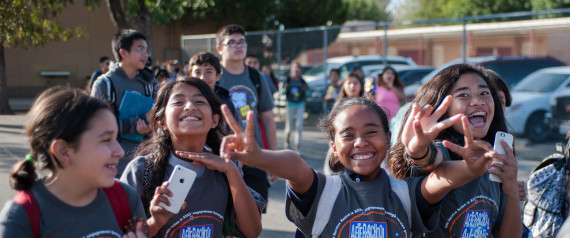For Millions of Kids, After-School Programs Light the Way

For millions of children, the bell at the end of school only signals a pause in their daily education. In after-school programs around the country, millions of children close their textbooks and put away their pencils, but instead of going home, they build robots, practice Tae Kwon Do, play in a band, receive homework support or participate in community service.
Whatever the activity, countless families who rely on after-school programing agree: the programs fill a much-needed gap between the ringing school bell at 3pm and the time mom and dad head home at 6pm.
Sadly, after-school programs aren't available everywhere. While millions of children attend, many more are denied the opportunity.
Ivonne Gonzales was one such kid left on her own after school until her parents enrolled her in an After-School All-Stars program. Before long, she learned to play the guitar, and soon, the East LA native was writing and recording her own music, and even performed at the Hollywood Bowl. She summed her after-school experience up in one word: "transformative."
"A lot of children have that voice, a voice to show the best of themselves to the world and change their communities, but they don't get a chance to develop that voice," she told me recently. "My after-school program was a way for me to develop that inner-spark that I had."
While participation in after-school programs has increased, the demand for after-school continues to rise at a pace that outstrips the growth of new programs. Currently, two in five children -- 19.8 million in all -- would participate in after-school if programs were available. Moreover, 11.3 million of those children don't have another option, and spend time alone and unsupervised during the after school hours. When I told this to Ivonne, I could hear the sadness in her voice.
"You grow up in a world of the American dream," she said before hesitating. "But there are still a lot of gaps in opportunity, which is where these programs have to come in."
Far too often, the American dream leaves some groups -- namely minorities and the poor -- behind. After-school programs are a critical way to combat this: research shows that participation in, and demand for, after-school programs are much higher among African American and Latino children from low-income households. Half of children from low-income households not participating in an after-school program would be enrolled in one if one were available to them.
While new after-school opportunities gradually open up for children, there is a long way to go for the 11.3 million students who are unsupervised after school and the millions more who would take advantage of the programs if given the chance. I spend a lot of time thinking about these numbers and citing research that highlights the positive impact after-school programs provide but I find that one of the strongest arguments is the simplest: when I am not with my kids, I worry about them. If I can't watch them myself, I want to know they are being looked after and using their time productively. After-school programs provide all parents, including me, a peace of mind.
The mission of After-School All-Stars is to provide free, comprehensive after-school For Millions of Kids, After-School Programs Light the Way | Ben Paul:
